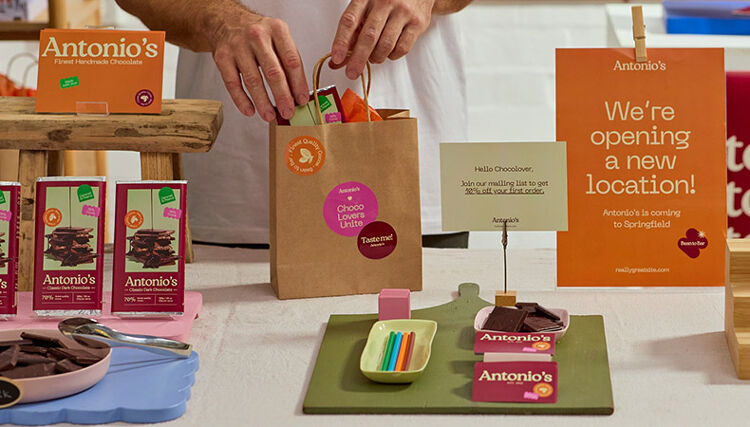Exclusive Label printing: inks, varnish, structures

Labels can help make a product more attractive. Sonja Angerer discusses the existing possibilities for producing exclusive added value labels and the business opportunities for digital printing.
Exclusive labels play a crucial role in many industries, they not only contribute to brand identification, but also add value to the products. This is especially true with luxury goods, where presentation is almost as important as the product itself. High-quality labels and elaborate packaging convey quality and prestige, 2 key elements that customers expect from premium brands.
Exclusive labels are also important in the food and beverage industry, as they help communicate trust and authenticity. In the pharmaceutical industry, they are not only for aesthetics, but also for security reasons as they show important information.
In the cosmetics and personal care sector, the appearance of a product has a strong influence on purchasing behaviour, exclusive labels can significantly affect brand loyalty. In Consumer Electronics (CE), where innovation and technology are paramount, unique and eye-catching labels are a way to stand out in a highly competitive market.
 Caption: The MGI AlphaJet can produce labels with varnish and digital hot foil stamping. Image credit: Konica Minolta / MGI.
Caption: The MGI AlphaJet can produce labels with varnish and digital hot foil stamping. Image credit: Konica Minolta / MGI.
What are the different types of exclusive labels?
Exclusive labels can be different from standard labels in many ways:
- Printing inks: multi-colour printing, spot colours, reflex and night vision colours
- Size and shape: Special shapes need to be punched out or contour-cut
- Metallic elements: printing on metal foil, metallic paint or ink, hot or cold foil
- Structures: Full-surface or partial printing varnishing, 2.5 D structures, relief embossing, Braille
- Personalisation: Labels are provided with names or serial numbers
- Security features: To protect against counterfeiting or piracy, the labels bear additional features like security or invisible inks.
 Caption: Exclusive, printed labels can now also be ordered online. Pictured: Label prints from Etikett.de. Image credit: S. Angerer
Caption: Exclusive, printed labels can now also be ordered online. Pictured: Label prints from Etikett.de. Image credit: S. Angerer
Printing technologies for exclusive labels
Labels in large quantities are usually produced using analogue printing techniques: offset, screen printing or flexographic printing. For small and medium-sized batch sizes, digital printing has risen in popularity. Since no physical print template is needed, it is easy to produce regional, seasonal and even personalised and individualised labels.
Digital printing can also be used to produce high-quality labels. For example, many EFI Vutek printer models offer an option to apply a matte or glossy print varnish.
The current Canon Arizona 2300 series can build reliefs up to 4 mm high from UV varnish. The Mutoh XPJ-461UF and XPJ-661UF XpertJet printers can print Braille on rigid and flexible media.
Today, metal accents can also be easily applied in digital label printing. Roland DG Eco Sol Max Metallic Ink can be used to print gold and silver, and many other metallic shades on labels. In addition, MGI offers the AlphaJet, a single-pass printer that can add hot foil with embossing in a digital process.
The current HP-Indigo 7K Secure Press can use security inks for printing exclusive, forgery-proof labels. Various HP Indigo models can also work with neon inks. Digital printing solutions with neon are also available from SwissQprint and Canon.
Advances in digital printing technology have made it possible to produce exclusive labels even for short runs that are equal to their analogue counterparts. However, the price per print still is usually considerably higher with digital production. Hence, there are now several hybrid options for high-quality label prints.
Business opportunities in exclusive labels printing
Digital label printing is widely regarded as a growth market, particularly for high-quality labels as they are widely used in premium and luxury markets. Buyers of such products demand exclusive design and excellent quality.
Even if economic growth remains weak in some European markets, high-end target groups purchasing behaviours are expected to stay the same. This makes the printing of exclusive labels an attractive segment.
Today, high-quality labels are not only in demand by industry buyers, but there is also a growing demand for stickers from end consumers and small businesses. Labels for gifts, at events and even as advertising material have become increasingly popular. Many producers of handmade products also use exclusive labels, as exciting packaging increases the value of the product. It is therefore to be expected that digital printing of exclusive labels will continue to be a growth segment.
To discover the latest content that covers a wide range of sectors including labels and digital printing sign up for FESPA’s free monthly newsletter FESPA World available in English, Spanish and German.
Interested in joining our community?
Enquire today about joining your local FESPA Association or FESPA Direct
Recent news

The Rise of B2B in Print-On-Demand: Mastering Personalisation to Drive Growth
Rusty Pepper highlights the B2B shift in Print-On-Demand, focusing on personalisation's role in driving growth. He discusses market differences between Europe and the U.S., challenges in global scaling, and strategies for successful implementation. Experts will share insights at FESPA 2025, covering automation, fulfilment, and market trends.

Navigating the Evolving Landscape of Fashion, Print and Sustainability
In this podcast, Debbie McKeegan and April Holyome – head of Product at the luxury Italian brand 16Arlington discuss the evolving landscape of fashion at the Epson Textile Academy.
.jpg?width=550)
Awarding Talent: Joanne O’Rourke Wins the Epson Eco Stories Textile Challenge and Trip to FESPA 2025
Joanne O'Rourke won the Epson Eco Stories Textile Challenge, receiving an Epson SureColor SC-F100 printer and a trip to FESPA 2025 in May. The award highlights the importance of supporting emerging designers for a sustainable print industry. These "digital natives" drive innovation, sustainability, and technological advancement, crucial for the sector's future.

The importance of Personalisation in Direct Mail - The Power of Print
Jeroen van Druenen, CCO of Jubels discusses how personalised direct mail, especially print, boosts engagement and ROI by tailoring content to individual recipients. Using variable data printing (VDP), marketers create unique designs and offers, enhancing relevance and fostering stronger customer relationships. Physical mail's tangibility and lasting impact further amplify personalisation's effectiveness.